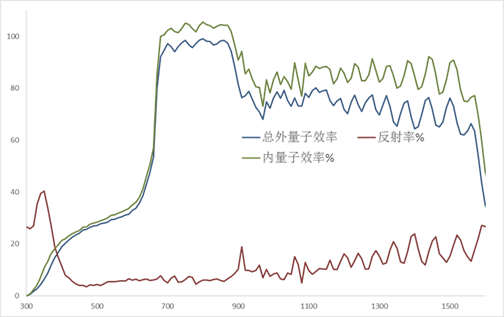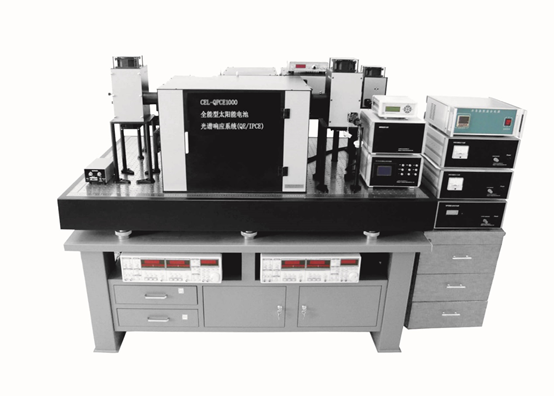Service hotline
+86 18518316054
 Current location : Home page > Products > Solar cell IV,QE/IPCE > CEL-QPCE1000 All-in-one Solar Cell Spectral Response System (QE/IPCE)
Current location : Home page > Products > Solar cell IV,QE/IPCE > CEL-QPCE1000 All-in-one Solar Cell Spectral Response System (QE/IPCE)

Model:CEL-QPCE1000
Place of Origin:Beijing
CEL-QPCE1000 all-purpose solar cell spectral response system (QE/IPCE) is mainly used to analyze various properties of semiconductor materials and solar cells, such as Spectral Reflectivity, Quantum Efficiency or IPCE ( Monochromatic Incident Photon-to-Electron Conversion Efficiency), Transmissivity, Current Density, etc.
1. Applicable cells: (single junction, double junction, triple junction), monocrystalline silicon, polycrystalline silicon, dye sensitization, amorphous silicon, microcrystalline silicon, gallium arsenide, indium gallium phosphorus, indium phosphide, germanium, cadmium telluride, copper indium selenide, copper indium gallium selenide, organic solar cells, polymer solar cells.
2. Measurement items: absolute spectral response, spectral transmittance, spectral reflectance, short-circuit current density, internal and external quantum efficiency, etc.
Spectral response curve: efficiency of converting light radiation of different wavelengths into electrical energy
Spectral Reflectance Curve: Response to the overall effect of reflective film and fleece production
External quantum efficiency curve: the total efficiency of photon conversion into electrical energy
Internal quantum efficiency curve: excluding the influence of reflected light, true response to the efficiency of photoelectric conversion
Instrument Advantages:
1. A variety of highly stable light source (xenon lamp, tungsten lamp, deuterium lamp, etc.) can be selected to ensure a wide spectral range of measurement
2. High-precision optical spectroscopy system, elimination of coma design, to ensure good wavelength accuracy and repeatability, small stray light; with automatic filter wheel, eliminate the impact of multi-level spectrum.
3. AC and DC measurement methods, electromagnetic shielding, super weak signal processing capability, high signal-to-noise ratio, to ensure measurement accuracy.
4. Specially customized sample chamber and patented sample holder, easy clamping, good electrode contact and low interference to weak signal test.
5. Independent research and development of weak signal controller, containing preamplifiers, automatic signal switching, to complete the switching of various types of signals.
6. Configure a variety of specifications bias filter for measurement.
7. The automatic shutter controls the opening and closing of the main light and polarized light, which is convenient for testing.
8. Constant temperature and variable temperature equipment to facilitate the temperature control of the battery cells.
9. Vacuum adsorption sample test bench, can customize the exclusive test bench.
10. Light path monitoring function, effective deduction of light source instability brought about by the test error, improve test accuracy.
11. Complete fully automated dedicated system software.
12. The software integrates the selection and parameter setting of the spectroscopic system, multi-stage spectral filtering device, weak signal switching, A/D, acquisition, processing and other equipment
13. Software automatic scanning, data calculation, and automatic generation and display of graphs and table files of calculation results, data and image backup and printout functions in various formats, and multiple data comparison functions
14. Automatic removal of software system error, automatic calibration of system error, linear error, periodic error and T error.
Main technical specifications
Indicators | Parameters |
Applicable batteries | Monocrystalline silicon, polycrystalline silicon, dye-sensitized, organic solar cells |
Control mode | Software control, fully automatic scanning, automatic error elimination, automatic background deduction |
Spectral range | 200-2500nm (optional) |
Scan interval | ≥1nm continuously adjustable |
Spectral scan | Fully automatic, continuous |
Repeatability of test results | <0.3% (short-circuit current) |
Operating mode | AC mode AC, DC mode DC |
Chopper frequency | 5-1000Hz |
Temperature control table. | Temperature control range 5-40℃ (±0.5℃), optional |
Bias light source | Configuration of two-way, can be more than three junction complex thin film cell testing |
Monochromator | Optional configuration of dual monochromator, dual optical path monitoring |

